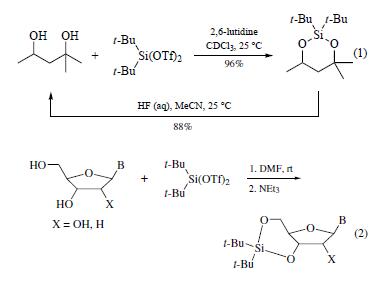DI-TERT-BUTYLSILYL BIS(TRIFLUOROMETHANESULFONATE) Chemische Eigenschaften,Einsatz,Produktion Methoden
R-S?tze Betriebsanweisung:
R34:Verursacht Ver?tzungen.
S-S?tze Betriebsanweisung:
S26:Bei Berührung mit den Augen sofort gründlich mit Wasser abspülen und Arzt konsultieren.
S36/37/39:Bei der Arbeit geeignete Schutzkleidung,Schutzhandschuhe und Schutzbrille/Gesichtsschutz tragen.
S45:Bei Unfall oder Unwohlsein sofort Arzt zuziehen (wenn m?glich, dieses Etikett vorzeigen).
Chemische Eigenschaften
Colorless to yellow liquid
Physikalische Eigenschaften
bp 73–75°C/0.35 mmHg; d 1.208 g cm?3.
Verwenden
Di-t-butylsilyl bis(trifluoromethanesulfonate)
is a reagent for the selective protection of polyhydroxy
compounds. This reagent reacts with 1,2-, 1,3-, and 1,4-diols
under mild conditions to give the corresponding dialkylsilylene
derivatives in high yield (0–50°C, 79–96%). Deprotection is
conveniently achieved by using aqueous hydrofluoric acid in acetonitrile
(eq 1).
Unlike di-t-butyldichlorosilane, this reagent reacts with hindered
alcohols. Even pinacol reacts to give the silylene derivative
(100°C, 24 h, 70%). Di-t-butylsilylene derivatives of 1,2-diols are
more reactive than those of 1,3- and 1,4-diols and undergo rapid
hydrolysis (5 min) in THF/H2O at pH 10, while the 1,3- and 1,4-
derivatives are unaffected at pH 4–10 (22°C) for several hours.
This protecting group is stable under the conditions of PDC oxidation
of alcohols (CH2Cl2, 25?C, 27 h) and tosylation of alcohols
(pyridine, 25°C, 27 h).
The reagent has seen limited use for the protection of alcohols
but has been used to protect nucleosides (eq 2).The procedure
consists of sequential addition of the ditriflate and triethylamine
to the nucleoside in DMF. The choice of solvent is critical.

synthetische
by the treatment of di-t-butylchlorosilane
with trifluoromethanesulfonic acid, followed by distillation
(71% yield).
DI-TERT-BUTYLSILYL BIS(TRIFLUOROMETHANESULFONATE) Upstream-Materialien And Downstream Produkte
Upstream-Materialien
Downstream Produkte

